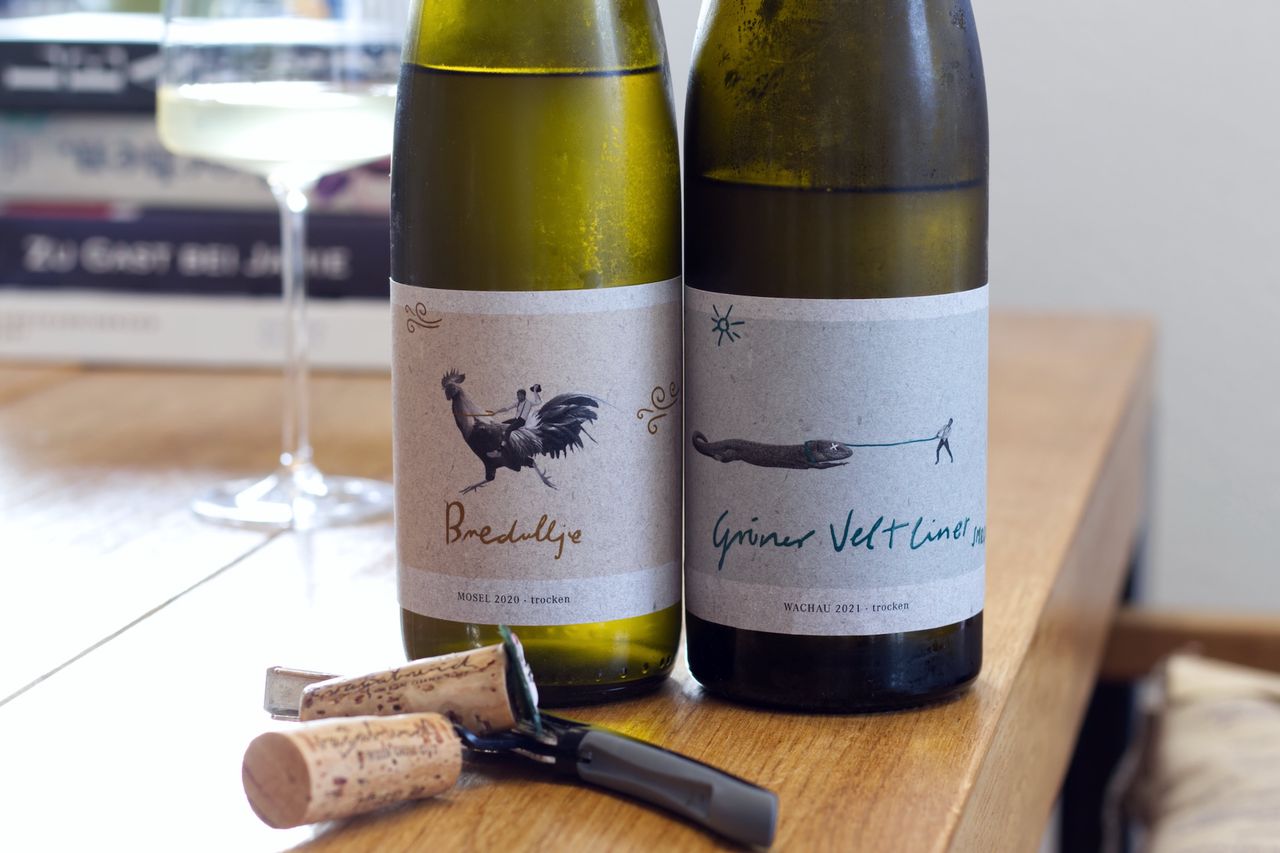Two Bottles Vagabund
Without owning his own estate, Jochen Fleischmann produces wine from various vineyards across Europe, and today we're tasting a Riesling Bredullje from the Mosel region, as well as a Grüner Veltliner SMRGD from the Wachau.

We all know why I bought these two bottles. I mean, there’s a guy riding a rooster on the label. With a hat. How could you not buy that? At the same time, the combination of Riesling from Zeltinger Himmelreich in the Mosel region and Grüner Veltliner from the Wachau in Austria, both from the same producer, is quite intriguing. Since 2019, Jochen Fleischmann has been making wine under the name Vagabund from various corners of Europe. After a generational conflict thwarted his plans to take over the family winery following his training in Geisenheim, Jochen started from scratch. Now he makes wine with minimal intervention from vineyards that he finds exciting. This means tiny quantities. There are only 800 bottles of the Riesling Bredullje 2020 and just 500 bottles of the Grüner Veltliner SMRGD 2021. The Riesling is quite unique anyway, as it was originally intended to be a slightly sweet Kabinett, but ended up fermenting completely dry. It then spent a year in barrel, together with a fifth of the wine that fermented on the skins, before being bottled, yet it still only has 9.5% alcohol. The Veltliner meanwhile holds the record for the toughest wax capsule I’ve ever encountered. I tried to chip it away with a butter knife, slipped, and cut my thumb. Not a great start, but hopefully worth it.
The Riesling is quite straightforward. Almost austere, yet very typical Riesling on the nose. Stone fruit and mineral notes, citrus in the background, and you can faintly detect the skin contact fermentation. Upon tasting, it’s super crisp, with green, just ripe apple and citrus notes. It’s long and has a good tension. You could easily empty a bottle of this alone. The yellow citrus fruit evolves into more orange with air, becoming even wilder. I really like that.
And on the second evening, the development continues. It’s even juicier and a bit wilder. You can feel the skin contact fermentation more, there’s just more structure, more earthiness. Drinking it feels like squeezing lime directly onto your tongue, with herbal notes and that apple again. It’s hard to believe this was an accident and wasn’t meant to turn out this way. It’s just too good for that, and maybe the yeast should fully ferment through every year. With each moment exposed to air, the wine opens up more, becomes even more untamed, more yeasty, and actually juicier. You begin to understand why there’s a guy riding a rooster on the label. It fits very well.
With the SMRGD, right after uncorking, all I get is a blast of ice candy. I don’t like ice candy. Not in wine, and even less as candy. First, the wine demands a blood sacrifice, then this. It can only get better from here. Nevertheless, I find it intriguing that the Veltliner smells so strongly of it as I usually associate ice candy with cold-fermented aroma yeast, which surely isn’t present in this wine. The better half across the table shares that impression, by the way. So, it’s not just my nose playing tricks on me. Swirling the glass helps, though. The wine becomes more yellow on the nose, gains a touch of peach, but can’t quite shake off the candy. However, on the palate, it’s different, there’s immediate peach, spiciness, and structure, which then smoothly fades away creamy at the back of the tongue. And as it rests on the palate, the candy completely disappears from the aroma. Rarely have I felt that I might have been way too early with a wine. But here, I fear I might have hit a strange phase.
Day two somewhat confirms this. Because now, there’s no ice candy in sight. The fruit is slightly exotic and stands side by side with the herbal spiciness in the wine. And even on tasting, there’s spice, saltiness, and structure. There’s real energy here. Incidentally, it’s proof of how irrelevant color often is. What you see in the picture in the glass isn’t diluted, it’s actually that light. Even without backlighting. It’s impressive how much better this wine has become after a day. It’s extremely good now, and I can only recommend either decanting the bottle directly into a carafe, uncorking it a day in advance, or actually forgetting about it in the cellar for some time. Otherwise, you might really miss out. Unless you like ice candy. In that case, like us, take a sip right away. And then, impressed like us, follow the evolution, which is surely the most dramatic overnight improvement I’ve experienced in a very long time. A real experience and a bottle worth displaying on the cupboard. It just looks too good for the recycling bin.
Related Posts
- Heymann-Löwenstein - Uhlen Blaufüsser Lay 2020
- Carl Loewen - Maximin Herrenberg 2018
- Two Bottles Riesling by Weiser-Künstler